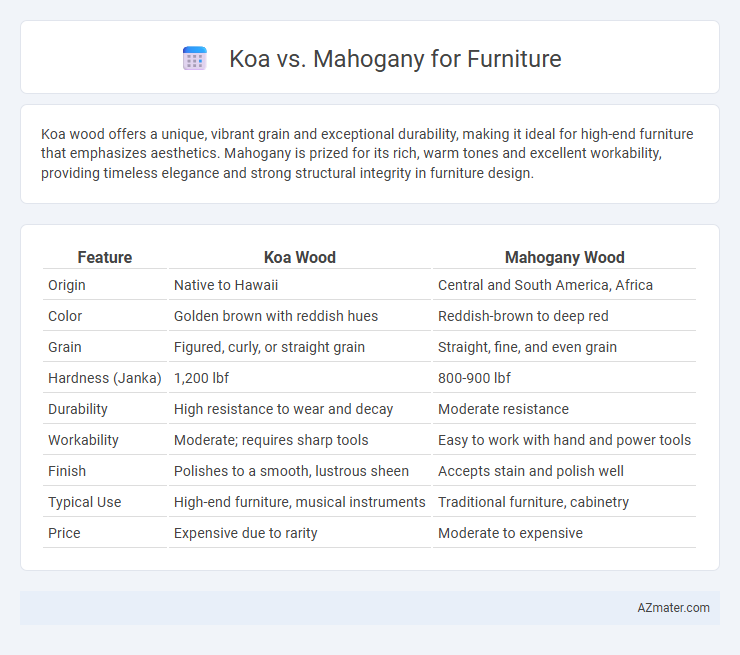Koa wood offers a unique, vibrant grain and exceptional durability, making it ideal for high-end furniture that emphasizes aesthetics. Mahogany is prized for its rich, warm tones and excellent workability, providing timeless elegance and strong structural integrity in furniture design.
Table of Comparison
| Feature | Koa Wood | Mahogany Wood |
|---|---|---|
| Origin | Native to Hawaii | Central and South America, Africa |
| Color | Golden brown with reddish hues | Reddish-brown to deep red |
| Grain | Figured, curly, or straight grain | Straight, fine, and even grain |
| Hardness (Janka) | 1,200 lbf | 800-900 lbf |
| Durability | High resistance to wear and decay | Moderate resistance |
| Workability | Moderate; requires sharp tools | Easy to work with hand and power tools |
| Finish | Polishes to a smooth, lustrous sheen | Accepts stain and polish well |
| Typical Use | High-end furniture, musical instruments | Traditional furniture, cabinetry |
| Price | Expensive due to rarity | Moderate to expensive |
Koa vs Mahogany: An Overview
Koa wood, native to Hawaii, offers a rich golden to reddish-brown hue with striking curly grain patterns, making it a luxurious choice for fine furniture. Mahogany, widely sourced from Central and South America, features a deep reddish-brown color with a straighter grain and is prized for its durability and workability. When comparing Koa vs Mahogany, Koa is often favored for its unique aesthetic and rarity, while Mahogany is valued for its consistent strength and classic warmth in furniture design.
Origin and Availability
Koa wood, native to Hawaii, is prized for its rich, golden to reddish-brown hues and limited regional availability, making it a rare and premium choice for furniture. Mahogany, originating primarily from Central and South America, is widely available and renowned for its deep reddish-brown color and fine grain, offering more consistent supply for furniture manufacturing. The scarcity of Koa increases its value, while mahogany's broader availability supports diverse furniture styles and budgets.
Appearance and Grain Patterns
Koa wood features a rich, honey-brown color with striking, interlocking grain patterns that create a wavy, curly appearance ideal for decorative furniture. Mahogany displays a deep reddish-brown hue with straight, fine, and even grain, offering a classic and elegant look that ages beautifully over time. Both woods provide unique visual appeal, but Koa's vibrant, chatoyant grain contrasts with Mahogany's smooth, consistent texture.
Durability and Hardness
Koa wood offers moderate durability and hardness, with a Janka hardness rating of approximately 1,560, making it resistant to dents and wear but less hard than mahogany. Mahogany, commonly recognized for its superior durability, boasts a Janka hardness rating between 800 and 900, which may be softer but has excellent resistance to rot and insect attacks, ensuring longevity in furniture applications. Koa is prized for its unique grain patterns and stability, while mahogany's toughness and decay resistance make it a preferred choice for high-end, durable furniture.
Workability and Ease of Use
Koa wood offers moderate workability with a fine, straight grain that machines smoothly but can cause occasional tear-out due to its interlocking grain patterns. Mahogany is highly valued for its excellent workability, featuring a straight, even grain that cuts and sands effortlessly, making it a preferred choice for intricate furniture details and carving. Both woods respond well to hand and power tools, but mahogany's consistent grain and stability provide superior ease of use for woodworking projects.
Cost Comparison
Koa wood, primarily sourced from Hawaii, is significantly more expensive than mahogany, typically costing two to three times as much per board foot due to its rarity and unique grain patterns. Mahogany, widely available from Central and South America, offers a more affordable option for high-quality furniture, with prices often ranging between $10 to $30 per board foot compared to koa's $60 to $120. The higher cost of koa reflects its premium status and limited supply, making mahogany a cost-effective choice without sacrificing durability and aesthetic appeal.
Sustainability and Environmental Impact
Koa wood, native to Hawaii, is highly valued for its sustainability due to controlled harvesting practices and reforestation efforts, making it an eco-friendly choice for furniture. Mahogany, often sourced from tropical rainforests, faces challenges related to deforestation and illegal logging, raising concerns about its environmental impact. Choosing Koa supports sustainable forestry initiatives and helps preserve biodiversity, whereas opting for certified sustainable mahogany can mitigate ecological harm.
Applications in Furniture Design
Koa wood, prized for its rich grain and warm reddish-brown hues, is ideal for high-end furniture such as tabletops, veneers, and decorative inlays, offering both durability and aesthetic appeal. Mahogany, known for its consistent texture and deep reddish-brown color, excels in classic furniture design including cabinets, chairs, and intricate carvings, providing excellent workability and long-lasting strength. Both woods enhance furniture with unique visual and structural qualities, with Koa favored for its exotic look and Mahogany for its stability and traditional elegance.
Maintenance and Longevity
Koa wood, prized for its rich grain and natural oils, requires less frequent sealing and resists moisture better, making maintenance simpler compared to Mahogany. Mahogany's dense, fine-grain structure demands regular polishing and protection against humidity to prevent warping and surface dullness. Both woods boast impressive durability, but Koa's natural resistance to decay ensures slightly greater longevity in high-humidity environments.
Which Wood is Best for Your Furniture?
Koa wood, renowned for its rich, warm tones and exceptional durability, is ideal for high-end furniture requiring both aesthetic appeal and long-lasting strength. Mahogany, prized for its deep reddish-brown color and fine grain, offers excellent workability and resistance to swelling, making it a favorite for classic, elegant furniture designs. For furniture that demands a balance of beauty, resilience, and smooth finish, Koa provides a unique tropical allure, while Mahogany suits traditional styles with its timeless sophistication and structural reliability.

Infographic: Koa vs Mahogany for Furniture
 azmater.com
azmater.com